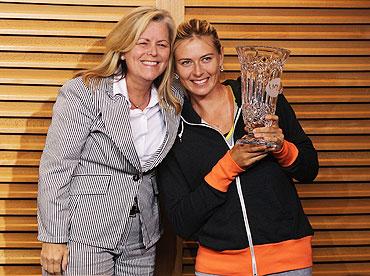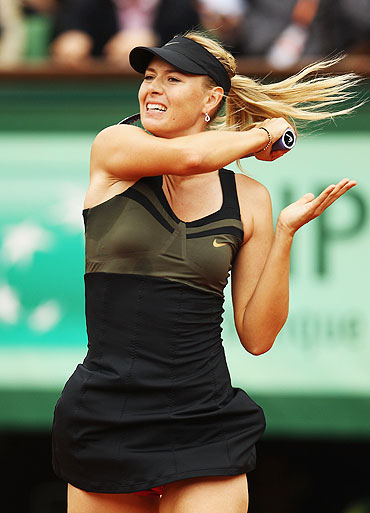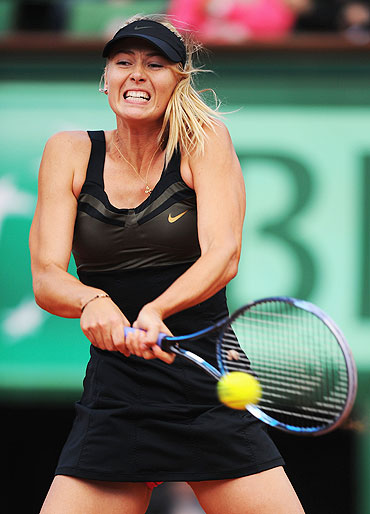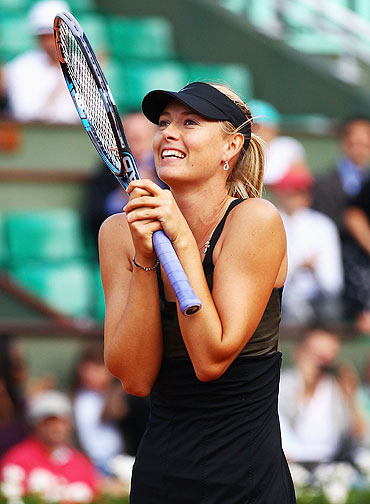 | « Back to article | Print this article |
Dogged Sharapova fights pain to reclaim top spot
When a groggy Maria Sharapova woke up after the effects of the anaesthetic wore off following shoulder surgery in August 2008, it was not long before the doubts started to race through her overworked mind.
Was the surgery successful?
Would she be able to serve at a competitive level again?
Would she ever be able to play top level tennis again?
Would she ever be pain-free again?
What she did not dare to dream about, though, was that less than four years later she would be on the cusp of completing her collection of Grand Slam titles and back on top of the world.
Her 6-3, 6-3 French Open semi-final win over Petra Kvitova took her within two sets of completing a remarkable comeback that many athletes dream of, but only the most determined and single-minded achieve.
'There's a lot of tough things you have to go through to get to this point'
"I was in a position a few years ago where I didn't quite know if I would ever be here again on this stage playing professionally," Sharapova, who will face Italian outsider Sara Errani in the final, said as she kept fingering a crystal vase she was given for reclaiming the top ranking.
"And not just at that, but at a level to get to No. 1 in the world and a first Roland Garros final for me.
"It's a long road back; it's a long process. It's a lot of days of frustration and uncertainty not knowing if you'll ever get there, not knowing how much you want it, not knowing whether it would be a moment like that for you again.
"So there's definitely a lot of tough things you have to go through to get to this point, but when you get here and you look back at the things that you did and the work that you put in and the toughest days that you can remember, it's all really worth it."Sharapova's fitness declined after her 2008 Aus Open triumph
The fact that Sharapova has managed to get where she is should come as no surprise to anyone who has followed the popular Russian's career.
Although the world did not know it then, Sharapova's burning desire to succeed was already evident when she was a precocious seven-year-old.
She left her mother behind in Russia, a separation that lasted for two years, and arrived in the United States in 1994 with a paltry $700 in her pocket and the dream of one day playing on the Centre Court at Wimbledon.
That dream was realised at just 17 when she unexpectedly triumphed in 2004 on the hallowed turf. She added a US Open crown in 2006 and the Australian Open prize in January 2008. Just a few months later it all started to go wrong, badly and painfully.'I committed myself to this sport'
Unable to fire-up her serving arm, she was left wondering if and how she would ever come back as she went under the surgeon's knife.
She even had to re-learn her serving motion as her old one no longer worked.
But hard work, and hours and hours of it, held no fear for a woman who was willing to make every sacrifice in the book, and then some, to achieve her dream.
"I have played tennis since I was four years old," she explained on Thursday.
"I committed myself to this sport. I've always loved what I did. When it was taken away from me for a while, that's when I realised how grateful I was and how lucky I was to be playing it."'I'm certainly grateful for the experience that I have'
"The day that I got shoulder surgery I knew it (the serve) was something I'm going to be working on and trying to get back for a very long period of time. It was the most painful shot for me before I had to get surgery, and I knew that it could have still been painful after. It certainly was for a period of time."
No one would have blamed her if she had walked away from it all, and as the richest woman in sport with millions in the bank she certainly did not need the money. But while money might have been the driving force when she had only $700 to her name, it no longer is.
"To be in this stage for the first time in my career, 25 years old, is just a great personal achievement," she said.
"I'm certainly grateful for the experience that I have. Experience I think is priceless. It teaches you so many things. Winning, losing, situations, circumstances that you go through."

© Copyright 2025 Reuters Limited. All rights reserved. Republication or redistribution of Reuters content, including by framing or similar means, is expressly prohibited without the prior written consent of Reuters. Reuters shall not be liable for any errors or delays in the content, or for any actions taken in reliance thereon.




